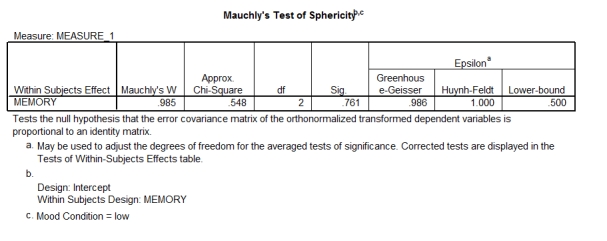Multiple Choice
A nutritionist conducted an experiment on memory for dreams. She wanted to test whether it really was true that eating cheese before going to bed made you have bad dreams. Over three nights, the nutritionist fed people different foods before bed. On one night they had nothing to eat, a second night they had a big plate of cheese, and the third night they had another dairy product, milk, before bed. All people were given all foods at some point over the three nights. The nutritionist measured heart rate during dreams as an index of distress. Which statement is the correct way to report these results? 

A) There was no significant effect of food on the distress caused by memories, F(2, 76) = 2.27, p = .11.
B) There was a significant effect of food on the distress caused by memories, F(2, 76) = 2.27, p < .05.
C) There was a significant effect of food on the distress caused by memories, F(1.97, 74.90) = 2.27.
D) There was no significant effect of food on the distress caused by memories, F(1.97, 74.90) = 2.27.
Correct Answer:

Verified
Correct Answer:
Verified
Q21: Which of the following is a test
Q22: A sports dietician wanted to test the
Q23: Exercise Two-way repeated-measures ANOVA compares:<br>A)Two means when
Q24: Imagine we were interested in the effect
Q25: What is the additional assumption that is
Q26: Imagine we were interested in the effect
Q27: Which of the following statements is false?<br>
Q28: What is Sphericity?<br>A)A form of compound symmetry,
Q29: A researcher in a retail-marketing unit wanted
Q30: When conducting a repeated-measures ANOVA which of